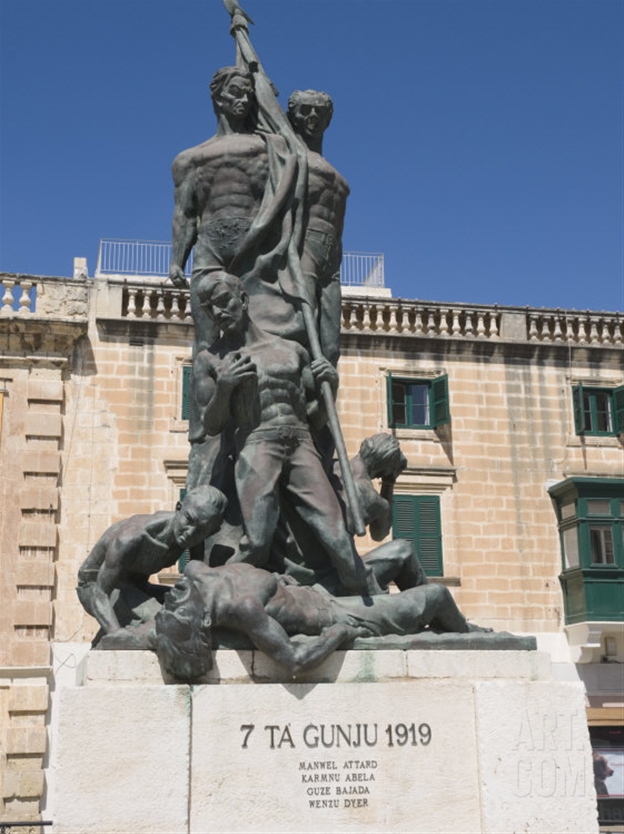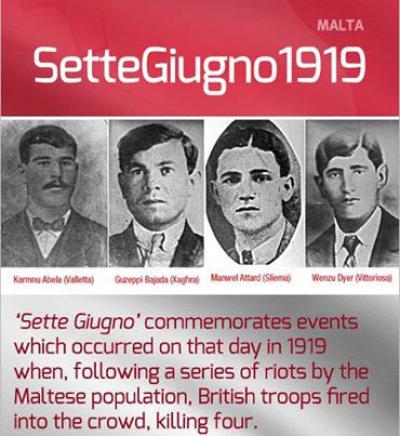
| A Day in Maltese History Guze’ Bajjada Karmenu Abela Lorenzo Dyer Manwel Attard
THERIOTS OF THE 19 JUNE 1919 Sette Giugno (7 June) is one of Malta’snational days. It is the day to commemorate the death of four Maltese rioters on June 7, 1919. The incident is now marked as a day when Maltese nationalism first surfaced during the BritishColonial period. This was a time when Malta’s economy was dominated by itsstatus as a military outpost. The price of grain had risen sharply, and pricesof bread were to increase. This was largely due to the fact that Maltese merchants were crippled by the costs of insuring their cargo, due to the threatto shipping in the Mediterranean. The flour merchants pleaded with the British government of the time to allow a subsidy, but they were scoffed at. And so,bread prices spiked and the life of Maltese people went from hard toharder. On the day, they converged onValletta, and the government of the time had no idea what was in store. It completely underestimated the gravity of the situation. The first spark of unrest centred on theMaltese flag defaced with the Union Jack flying above the “A la Ville deLondres.” This incident sparked the uprising. The death of the President of theCourt some days earlier had required all governmental departments to fly theUnion Flag at half mast, including the Bibliothèque buildings in PjazzaRegina, and the meteorological office. The crowd moved on to the meteorological offices, housed in a Royal Air Force turret. After breaking the glass panes, the mob entered the offices ransacking and destroying everything inside.Some individuals climbed onto the turret, removing the Union Jack and throwing it into the street. The crowd burned the flag along with furniture taken from the offices nearby. In Strada Teatro, the offices of the DailyMalta Chronicle were broken into, with pieces of metal jammed in the workings of the presses to break them. While this was taking place, other crowds wereattacking the homes of perceived supporters of the Imperial government andprofiteering merchants in Strada Forni. Ten soldiers, led by Lieutenant Shields, approached the offices of the Chronicle, which were surrounded by acrowd which then began to throw stones and other objects at the soldiers. The same happened in Strada Forni, where six soldiers were trying to stem a crowd of thousands. The soldiers broke and opened fire. The firstvictim of the uprising, Manwel Attard, fell in front of the Cassar Torregiani House. Other individuals were injured. Ġużè Bajjada was hit near Strada Teatro,and fell on top of the Maltese flag he was carrying. The officer in charge began shouting for the firing to cease. Meanwhile, in the Chronicle offices, anofficer ordered his men outside, since there was an evident smell of gas in the building. To clear a way out, the officer ordered a soldier to shoot low, away from the crowd. This shot hit Lorenzo Dyer, who tried to run away. Disturbances continued the next day, with crowds attacking the palace of Colonel Francia, who also owned a flour-millingmachine. Royal Malta Artillery soldiers were used to protect Francia’s house, but they did not fire on their own people. The crowd forcedits way in and threw furniture, silverware and other objects outside. In theevening, one hundred and forty navy marines arrived, clearing the house and street of crowds. Carmelo Abela was in one of the side doorways of Francia’shouse, calling for his son. Two marines proceeded to arrest him, and when he resisted, a marine ran him through the stomach with a bayonet. Abela died onJune 16. |
|

